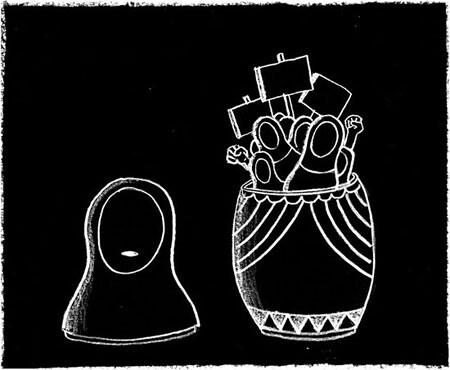Once again, the press has dismissed a popular movement as carnival—this time not Occupy Wall Street, but the anti-Putin protests. On March 1, 2012, in a Financial Times article titled “Carnival spirit is not enough to change Russia,” Konstantin von Eggert wrote, “One cannot sustain [the movement] on carnival spirit alone.”1 A little over a week later, Reuters sought to close the debate with an article by Alissa de Carbonnel, in which she announced, “The carnival is over for Russia’s three-month-old protest movement against Vladimir Putin.”2 On the contrary, it was just the beginning of Russia’s carnival.
Around the same time, Irina Sandomirskaja, professor of cultural studies at the Center for Baltic and East European Studies at Stockholm’s Södertörn University, wrote in an online article:
The world will be saved by the balagan (street theater playing farce).” In this carnivalesque paraphrase of the famous dictum by Dostoevsky, Lev Rubinstein, truly the brain and the tongue of Moscow’s recent political protests, and the one who currently occupies the position of “the Sun of Russian Poetry,” sums up the results of the political season that is swiftly moving to its end in the presidential election on March 4th.3
Described as “a fairground show, performed by itinerant players who traveled from fair to fair and frequented the Mardi Gras celebrations in Petersburg,” the balagan is no longer a mainstream popular entertainment in Russia.4 But its main figure, Petrushka (equivalent to Pierrot), the fool, might well be reincarnated in Lev Rubinstein, while other, heretofore unconceivable characters have since been added to the Russian carnival cast.
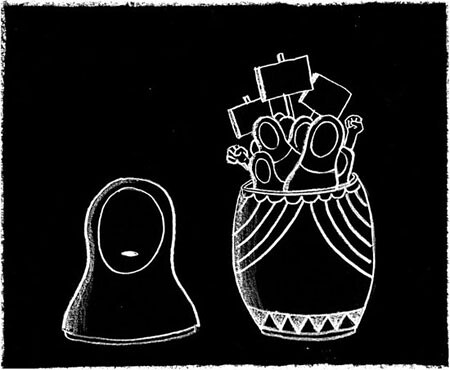

1. Post-Feminist Masquerade
Having stormed a half-empty Moscow cathedral in brightly colored tights, dresses, and ski masks, members of an all-female, self-proclaimed punk band performed a strident so-called punk prayer as a call to action to their fellow comrades. The arrest, subsequent trial, and current incarceration of Pussy Riot have since become history, but on that February 21, Pussy Riot’s antics hadn’t yet made it into the official record of the carnivalesque.
Did anyone notice the date? One Russian journalist, Mansur Mirovalev, of the Associated Press, retrospectively reported on Holy Mary, Drive Putin Away, Pussy Riot’s forty-second-long, lip-synched performance at Christ the Savior, that “[a]n outspoken cleric known for his liberal views call[ed] it a ‘legal outrage’ during Shrovetide week, when church tradition allows and even encourages carnival-like escapades and jokes.”5Shrovetide week is customarily designated for confession in the Christian calendar, rendering Pussy Riot’s catty song a strange confession. Perhaps more significantly, February 21, 2012 actually falls right on Mardi Gras day, the last sanctioned day of carnival revelry.
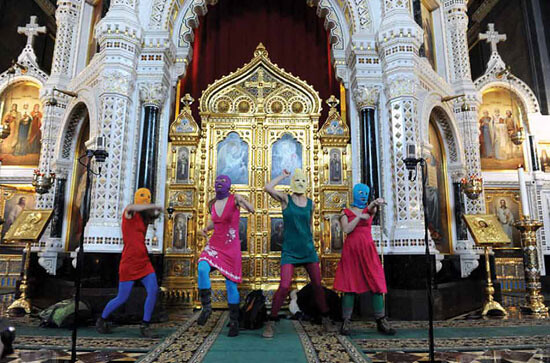

Given Pussy Riot’s careful calendrical choices, masterful use of symbols, and canny encoding of signs, it is hard to believe that it was merely coincidental that their iconoclastic performance took place on Fat Tuesday. Their first song, “Release the Cobblestones”—perhaps a veiled reference to the May 1968 slogan, “Sous les Pavés la Plage” (Under the Cobblestones, the Beach)—was released on November 7, 2011, the anniversary of the 1917 Russian Revolution. Pyotr Kropotkin, one of the founders of anarchism, was invoked in their song “Kropotkin Vodka,” which began as a series of impromptu performances, recorded and later released on the internet. Of their signature balaclavas, one band member, known as Shayba, said:
Masks are our visual style and a core principle of the group. We don’t want people to focus on us as individuals or biographies. We want people to look at us as an idea. It’s a principal [sic] of universality. We want people to think that anyone you see walking down the street can be a member of Pussy Riot.6
However, despite the band’s emphasis on anonymity, and contrary to their reported references to the American feminist artist-activist group Guerilla Girls and the broader riot grrrl and third-wave feminist movements, Pussy Riot appear to be engaged more in what Angela MacRobbie termed “post-feminist masquerade”—a return to patriarchal codes under the mantle of taken-for-granted feminism—than in feminist discourse tout court.7 “Even though we wear dresses, we make ‘unfeminine’ movements. It’s a multilevel way of breaking with traditional feminine behavior,” said band member Tyurya, calling into question the sophistication of their feminist rhetoric.8 And although Western journalists have fawned over Nadezhda Tolokonnikova’s August 8 closing statement at Khamovnichesky Courthouse, it was a hodgepodge of multifarious references ranging from Stephen, a follower of the Apostles, to French Renaissance thinker Montaigne, including none of their feminist forbearers. In lieu of feminist subjectivity, Tolokonnikova referred to herself and her two partners, Maria Alyokhina and Yekaterina Samutsevich, as “three girls” against whom “the political system has ganged up.” She recognized their “childish naïvete,” and she expressed feeling “overwhelmed” by Madonna’s support.9
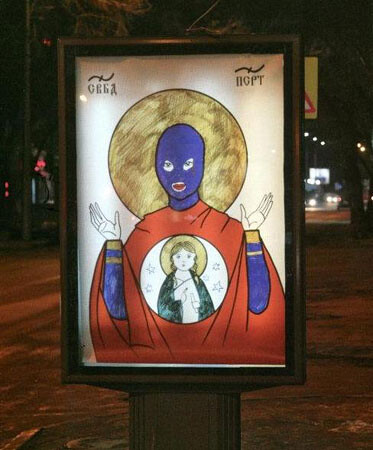

2. Mock De-Crowning
In spite of Pussy Riot’s efforts to agitate the flag of Western feminism and its long tradition of femininity as masquerade, it might be more revealing to look at their performances through the lens of carnivalesque discourse—which is not to say that Pussy Riot articulated a carnivalesque discourse any more than they did a feminist one. In the aforementioned closing statement, they did, however, root their practice in a solid tradition of Russian dissidence, citing Fyodor Dostoevsky and Aleksandr Vvedensky as sources of inspiration. Reflecting upon their own fate prior to their two-year imprisonment in a Soviet-style prison camp, they recounted biographical anecdotes—Vvedensky’s falsified death certificate and Dostoevsky’s staged firing squad—more than artistic achievements. Pussy Riot took Vvedensky’s “bad rhyme” as a model for their own slack sound, but not Dostoevsky’s invention of what Mikhail Bakhtin termed “the polyphonic novel,” a hallmark of his theory of carnivalization or carnival influence in literature. And yet, Pussy Riot’s performances are an almost perfect illustration of Bakhtin’s notion of carnivalesque acts and carnivalesque categories, as described in his Problems of Dostoevsky’s Poetics.10
The punk prayer, in its call for the removal of President Putin from office in the very cathedral where Patriarch Kirill officiates, is an updating and a doubling of the decrowning of the carnival king ritual, which is, according to Bakhtin, one of the dual aspects of the primary carnivalesque act of mock crowning/decrowning. Pussy Riot killed two kings with one song. If some Russian citizens felt that they had been robbed of the crowning of the king because of flawed elections, they wanted to make sure to take part in its decrowning through their protests. Pussy Riot’s performance acted as the catalyst for a process already underway but condemned to incompleteness: the first element of the dualistic carnival ritual, mock crowning, had itself been a mockery, for it was at the public’s expense rather than Putin’s. According to Bakhtin’s progressive view of history, the dual nature of the ritual in a “carnival sense of the world”—a world unknown to Putin—is “[…] the shift-and-renewal […] of all structure and order, of all authority and all (hierarchical) position.”11
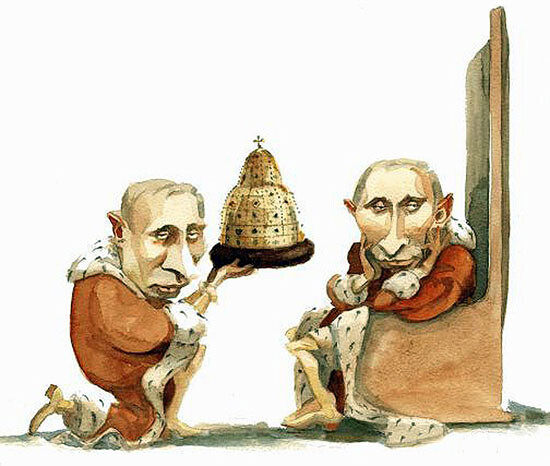

If Pussy Riot greatly contributed to the verbal debasement of Putin with an onslaught of obscenities, as in their January 20 “Putin Pissed Himself” Red Square performance, the crowd had already begun the war of words with slogans such as “Khutin Pui,” or “Puck Futin,” a sly inversion of “Fuck Putin.”12 Unlike in the American Occupy movement, where bankers and billionaires, rather than President Obama, were the target, the Russian protests are characterized by—indeed, were born of the desire to—dismantle the figureheads of the state and the church, the whole patriarchal superstructure as phallocratic supercherie. Symptomatically, the head of the Russian state and the head of the Russian Orthodox Church are referred to not by their formal titles as President and Patriarch, but by their last names Putin and Kirill, emphasizing the personalization of power and the illegitimacy of their function. Pussy Riot’s songs’ attack on Putin’s person is a response to what Ken Hirshkop has called “the official obsession with the proper name” that, according to Bakhtin, “signifies an intention to prolong an identity over time, without regard for specific qualities or achievements”—a more than sufficient summary for the musical chair arrangement played by Putin with Dmitry Medvedev.13
While carnivalesque acts have often been reduced to the order of the pseudo-revolutionary, is it not compelling to witness their repeated occurrence in contemporary protest movements, and might it not be useful to understand their function in the arc of a movement’s life, in this case to understand Pussy Riot’s emergence within the chronology of the Russian Protests? Here it becomes possible to observe Pussy Riot in light of Bakhtin’s Dostoevsky in particular, not least because it stems from the Russian context. This is not so much to enforce the idea of the carnivalesque as the coming revolution, or to emphasize the radical politics of these movements, but rather to understand why and how particular, formerly anachronistic cultural forms return to blend with current techniques of communication and bring momentum to contemporary emancipatory struggles—or, in not so many words, how culture informs politics.
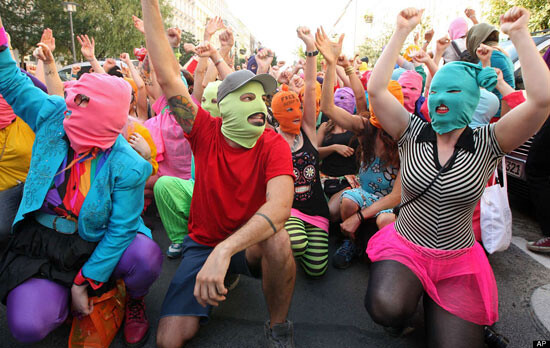

3. Aesthetic for Democracy
Both Ken Hirschkop’s Mikhail Bakhtin: An Aesthetic for Democracy (1999) and Michael Hardt and Antonio Negri’s Declaration (2012) deal with the notion of democracy, which the former sees as an irrelevant, and the latter as a corrupted, political project. Published the year of the Global Carnival Against Capital, Hirschkop’s book sticks strictly to Bakhtinian exegesis, while Hardt and Negri’s pamphlet, written in response to the 2011 movements, dispenses with the carnivalesque, which they had previously taken into account in Multitudes (2004).
One of the first things the Russian protests did, as all movements do, was bring people together. For Bakhtin, this is part of the carnivalesque category of “free and familiar contact among people”14 intended to break hierarchical relationships, facilitate the release of laughter, and dispel fear. In a well-known passage, he writes that “[carnival’s] sense of the world [as one great communal performance] liberat[es] one from fear.”15 For Hirschkop, however, contrary to what has often been said, Bakhtin’s fear was not so much the result of Soviet Russia’s crackdown on people perceived as dissidents as much as it was the result of the belief in archetypal human emotions. For Hardt and Negri, “the construction of political affects […] requires physical proximity,”16 and they characterize the process by which it occurs as “a being together.” On the topic of fear, to which they devote a section complete with examples from Tahrir Square to Puerta del Sol, they write:
We cannot fully explain how these militants achieved such a state of fearlessness, which must have been due, in large part, to their being together, but we can easily recognize its physical power and importance. Power cannot survive when its subjects free themselves from fear.17
While it is not possible for me to suggest that carnivalesque laughter could be at play in Egypt, it is easy to imagine that it is in Spain and in Russia, both of which have longstanding carnivalesque traditions. To translate a Bakhtinian concept into terminology from Hardt and Negri, laughter is a counterpower to fear. The origins of Russia’s carnivalesque are clear, while Spain’s are easy to sum up: for Bakhtin, Cervantes’ Don Quixote is a prime example of carnivalization and, as demonstrated by Victor Stoichita in Goya: The Last Carnival (1999), Goya’s work was infused with a deep understanding of the carnivalesque. So, the fearlessness Hardt and Negri could not fully explain is given elements of explanation from a cultural theory with which they are familiar but chose not to resort to in this instance.
But one of Hardt and Negri’s undisclosed carnivalesque contributions in Declaration is the idea of the “inversion of the subjective figures of the crisis in figures of power.”18 The very notion of inversion of subject positions is a classic carnivalesque process, while their further characterization of some of these subjectivities as the mediatized, the securitized, and the represented is particularly relevant to Russia’s brand of carnivalesque protest. (The other subjective figure of crisis is the indebted, which is particularly relevant to the American Occupy Wall Street movement.) What are Pussy Riot’s members, if not emblematic figures of the represented (which combine all other figures) who have empowered themselves and helped empower others? What have Pussy Riot done, if not given an iconic representation to the crisis of representative democracy? Pussy Riot have played no small part in providing heightened visual currency and affording new subjective agency to longtime followers and recent recruits (among whom are their previously skeptical parents themselves).
Pussy Riot’s performances—currently the apex of the carnivalesque arc of the Russian protests—are no doubt creating an aesthetic for democracy, according to Bakhtinian principles, as revisited by Hirschkop. Are they also constructing the commons, as Hardt and Negri envision? How many steps lie between the creation of a democratic aesthetic and the construction of a democratic political project? Is the carnivalesque a prefiguration of the political? Old tropes, however ineffectual, are easier to reformulate than to avoid altogether. Let’s rephrase: Is the recurring emergence of the carnivalesque in protest movements a function of their efficiency at clearing the space for the work of the commons? On Hardt and Negri’s checklist, only one of the four prerequisites for constructing the commons has been met: “the ability to create social bonds with each other.” The “power of singularities to communicate through differences” might only happen when a cross-section of Russia’s population, not just Moscow’s “cognitive precariat,” takes to the streets.19 The “real security of the fearless” might have come to a temporary halt with Pussy Riot’s imprisonment; it might also have heartened other activists to carry forth. The “capacity for democratic political action” might begin with a long appeal process in order to repeal an undemocratic verdict.


Hirschkop spends the length of his book grappling with Bakhtin’s separation of carnival culture and democratic politics, a weakness of the political potential of carnival, as most have argued. In his conclusion, he offers the following reckoning in support of the importance of the role of culture in shaping movements:
The democratization of social life is more than ideology; it cannot be reduced to the homage that every secular political movement pays to the authority of the people. A national vernacular, a mass electronic communications network, a system of population-wide formal education, and techniques for the mobilization of crowds in public spaces are facts embedded in modern ethical life, not mere constraints or tools, but realities that shape contemporary social relations. They may be politically mobile, and they are by no means either universal realities or ones destined to last forever, but for a large part of the world they represent a level of popular mobilization and power no political movement can ignore.20
This bears a striking resemblance to early-twenty-first-century Russia. That Putin seemingly chose to ignore the democratic nature of cultural life in Russia, even as it surfaced from beneath his undemocratic politics, is not surprising given the blinding nature of autocratic rule. That Pussy Riot dared confront him and create such a stir by exercising their democratic rights amped up with carnivalesque cultural memory might not yet be conclusive but can surely be conducive to hope.
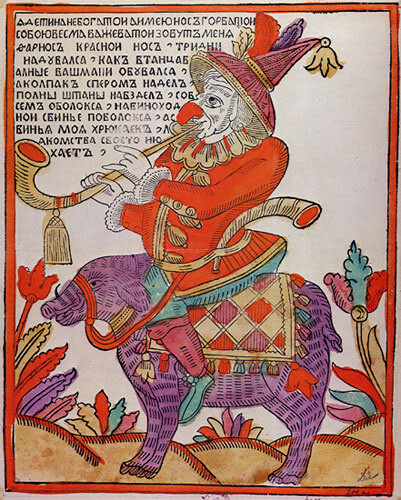

4. Return of the Balagan
Pussy Riot have already garnered a wide following around the world, albeit more so in Europe than anywhere else, and they are under discussion to copyright their name. On the day of or in the days immediately following their trial, balaclava-clad copycats, sometimes armed with guitars, attacked cathedrals and churches and other Christian religious symbols, which seem to have been their main target. A small group managed to climb up the Grossmuenster Cathedral in Zurich to tie up a monumental Pussy Riot Banner on the façade. On Sunday 19, two male Germans and a female Austrian were reported to have interrupted a church service at Cologne’s cathedral. The most carnivalesque aspect of these acts, in the absence of a coherent target, was their spontaneous solidarity. As for the members of the topless feminist activist group FEMEN, who assailed Patriarch Kirill on a visit to Kiev and used a chainsaw to cut down a cross, they missed the mark altogether with spectacular but uncarnivalesque actions devoid of the identificatory and counter-identificatory tensions that can provoke reversals of roles or functions like the symbolic decrowning of Putin and defrocking of Kirill.
“Russia takes to the streets to say goodbye to the regime,” says one free member of Pussy Riot in the latest released song, “Putin sets the Fires to Revolution.” Russia has been a country of revolutions before, and Pussy Riot has lit and extinguished their own fires in prior performances. Of the good intentions paving the road to democracy, Hardt and Negri joke about “[…] the Soviets who battling capitalist domination thought they were headed for a new democracy but ended up in a bureaucratic state machine.”21 There is little hope that an old-style communism or a nominal democracy will inaugurate a new era of cultural revolution. At the very least, Pussy Riot is well on its way to consolidating Russia’s democratic culture. “Russia takes to the streets to say goodbye to the regime. / Russia takes to the streets to say goodbye to the regime.” The refrain might well take Pussy Riot and their growing mass of supporters to the top charts, and the balagan then will make a full comeback to save the world.
Konstantin von Eggert, “Carnival spirit is not enough to change Russia,” Financial Times, March 1, 2012. See →.
Alissa de Carbonnel, “Carnival is over,” Reuters, March 9, 2012. See →.
Irina Sandomirskaja, “Khutin Pui, or What’s in Moscow? Election Campaign, a View from Below,” Baltic Worlds, March 1, 2012. See →.
Clayton, Douglas, J. Pierrot in Petrograd: The Commedia dell’Arte/Balagan in 20th century Russian Theatre and Drama (Montreal: McGill-Queen’s University Press, 1993), 10.
Mansur Mirovalev, “Pussy Riot: Guide to all six of their songs and how they reflect Russia’s anti-Putin uprising,” The Province, August 18, 2012. See →.
Charles Clover, “Pussy Riot dig claws into Putin,”Financial Times, March 16, 2012, See →.
See Angela MacRobbie, The Aftermath of Feminism: Gender, Culture and Social Change (London: SAGE Publications, Ltd., 2009).
Miriam Elder, “We are representative of our generation,”The Guardian, August 17, 2012. See →.
See →.
Mikhail Bakhtin, Problems of Dostoevsky’s Poetics, ed. and trans. Caryl Emerson and Wayne C. Booth (Minneapolis: University of Minnesota Press, 1984). In this translation, the word carnivalistic is used. I have chosen to use instead the more common and accepted word carnivalesque.
Ibid., 124.
Sandomirskaja, op. cit.
Ken Hirschkop, Mikhail Bakhtin: An Aesthetic for Democracy (New York: Oxford University Press, 1999), 279.
Bakhtin, 123.
Bakthin, 160.
Michael Hardt and Antonio Negri, Declaration (Argo Navis Author Services, 2012), 18.
Ibid., 42–3.
Ibid., 7. Also see Chapter 1: Subjective Figures of the Crisis, 9–30.
Ibid., 60 and Next: Event of the Commoner, 101–8.
Hirschkop, 293–4.
Hardt and Negri, 79.
The author welcomes any comments on this essay at carnivalagainstcapital [at] gmail.com
